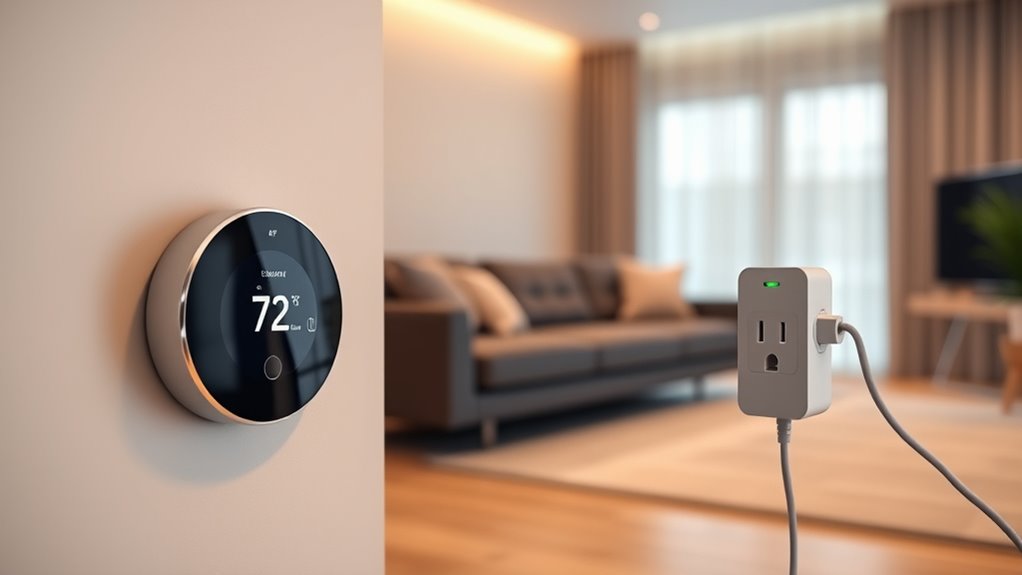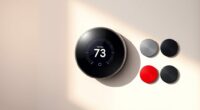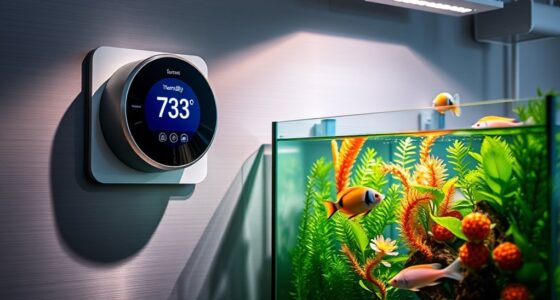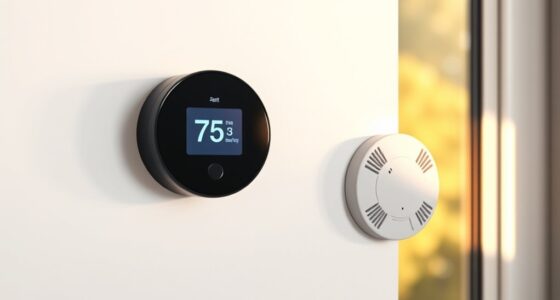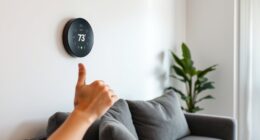Connecting your smart thermostat to a smart plug for your room heater lets you control and schedule heating remotely via your smartphone. This setup improves energy efficiency, helps prevent issues like overheating, and boosts safety with alerts and automatic shut-off features. It also makes managing your home’s comfort simpler and more reliable. If you want to explore how to set up and optimize this system, there’s more helpful information to discover.
Key Takeaways
- Connecting smart thermostats to smart plugs enables remote control and scheduling of room heaters for convenience.
- It enhances energy efficiency by preventing unnecessary heater operation and reducing utility bills.
- The setup offers safety features like overheat protection and real-time alerts for electrical faults.
- Users can set temperature limits and timers via apps to ensure safe and optimal heater use.
- Integrating these devices promotes a safer household environment with automated safety and energy-saving measures.

Connecting smart thermostats to smart plugs offers an easy way to control room heaters more efficiently and conveniently. This setup allows you to manage your heating devices remotely, giving you better control over your room’s temperature and energy use. By integrating these devices, you can set schedules, adjust settings from your phone, and guarantee your heater operates only when needed. This not only saves energy but also helps reduce utility bills over time. When you connect a smart thermostat to a smart plug, you’re creating a system that responds automatically to your preferences, preventing unnecessary heater operation and promoting smarter energy consumption.
One of the key benefits of this setup is improved energy efficiency. Instead of leaving your heater on all day or guessing when it should turn off, the combination of a smart thermostat and smart plug allows you to fine-tune its operation. For example, you can program the heater to turn off when you leave the house or when a certain temperature is reached, ensuring you’re not wasting energy heating an empty room. This targeted control minimizes energy waste, making your home more eco-friendly and helping you save money in the long run. Additionally, many smart thermostats feature learning capabilities that adapt to your habits, further optimizing energy use without sacrificing comfort.
User safety is another essential aspect of connecting smart thermostats to smart plugs. These devices often come with built-in safety features like overload protection and real-time alerts if the system detects any irregularities. For instance, if your smart plug senses an overheating issue or a potential electrical fault, it can automatically shut off the power to prevent accidents or damage. This added layer of safety is particularly important for room heaters, which can pose fire hazards if not properly managed. With remote monitoring and control, you can quickly turn off the heater if you notice any unusual behavior, giving you peace of mind even when you’re away from home.
Furthermore, many smart systems allow you to set safety parameters, such as temperature limits or timers, directly through their apps. This ensures your heater isn’t left on indefinitely or operated beyond safe levels, reducing the risk of fire or electrical issues. Incorporating safety features into your smart setup is crucial for maintaining a secure environment. By connecting your smart thermostat to a smart plug, you create a safer environment for everyone in your household. As technology advances, the importance of incorporating high-quality projectors into your home setup underscores the value of reliable and safe control systems. Overall, this combination makes managing your room heater simpler, smarter, and safer, empowering you to maintain a comfortable space while prioritizing energy efficiency and user safety.
Frequently Asked Questions
Can I Use Any Smart Plug With My Thermostat and Heater?
When considering if you can use any smart plug with your thermostat and heater, you need to check device compatibility and brand limitations. Not all smart plugs work seamlessly with every thermostat or heater, as some require specific protocols like Zigbee or Z-Wave. Always verify that the smart plug you choose is suitable for your existing devices, and stick to reputable brands to ensure safety and reliable performance.
What Safety Precautions Are Necessary When Connecting These Devices?
Did you know that improper electrical safety measures cause over 30% of household fires? When connecting smart devices, always check device compatibility to prevent issues. Make certain your smart plug and heater are rated for the same voltage and wattage. Avoid using damaged cords or outlets, and keep water away. These steps help protect your home and prevent electrical hazards, making your smart setup safe and reliable.
How Does This Setup Impact Energy Efficiency and Costs?
You’ll notice that this setup can boost your energy savings by allowing precise control over your room heater. When you connect smart thermostats to smart plugs, you can schedule heating times and turn off devices when not needed, leading to significant cost reduction. This automation minimizes energy waste, helping you save money on your bills. Overall, it’s an efficient way to manage heating while keeping costs down.
Is Professional Installation Recommended for Complex Setups?
If your setup is complex, professional wiring is definitely recommended. You’ll need someone with technical expertise to guarantee safety and proper functionality. Attempting DIY installation on intricate systems can lead to wiring mistakes or damage, which might void warranties or cause hazards. Hiring a professional guarantees that your smart thermostat and plugs are correctly integrated, giving you peace of mind and ideal performance.
Are There Compatibility Issues With Specific Brands or Models?
You might face compatibility issues depending on your smart device brands and models. Some smart thermostats and smart plugs have brand compatibility limitations, meaning not all work seamlessly together. Always check the specific model limitations and compatibility lists before purchasing. If you choose brands known for broad compatibility, you’ll reduce setup frustrations and guarantee smooth operation for your room heater automation.
Conclusion
By connecting your smart thermostat to a smart plug for your room heater, you can save up to 15% on energy bills annually. This setup gives you precise control, reduces waste, and boosts efficiency. With over 90% of users reporting increased comfort and savings, it’s clear that smart integrations make a real difference. So, take advantage of this technology to stay cozy while cutting costs—it’s a simple step toward smarter living.
